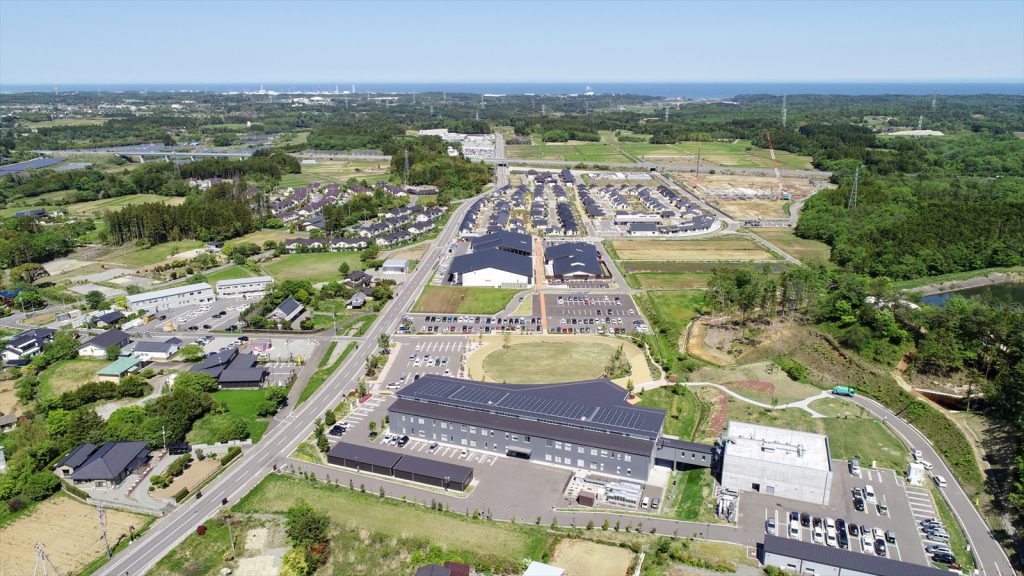実施日 : 2023年02月14日(火) - 15日(水)
Fukushima Press Tour
投稿日 : 2023年01月20日
Fukushima Press Tour
<Tour Dates: Tuesday, February 14 - Wednesday, February 15, 2023
Sponsored by the Ministry of the Environment>
[Tour Topics]
①Building a New Town for the Future in Okuma
②Decarbonization and Reconstruction: Namie’s Challenge
As of March this year, twelve years will have passed since the Great East Japan Earthquake and the TEPCO’s Daiichi Nuclear Power Station accident. In the areas in Fukushima which suffered greatly due to the nuclear accident, evacuation orders have been gradually lifted as decontamination efforts are complemented, and the municipalities have begun moving steadily toward the future with their reconstruction efforts.
In Okuma, where Fukushima Daiichi is located, the entire town was placed under evacuation orders after the accident, and approximately 11,000 residents of in total had to evacuate. Some of the evacuation orders were lifted in April 2019 and in June 2022, and former agricultural land was developed into a new base for reconstruction, with a new town hall, public housing, and commercial facilities. With the town reopening, residents have returned hoping to rebuild their hometown alongside new residents, and new community-building initiatives have started to restore this town’s previous vitality after having its population temporarily drop to zero.
North of Okuma, the town of Namie, with its town hall approximately eight kilometers from the nuclear power station, had evacuation orders for the whole town, but in March 2017, those orders were lifted for areas where approximately 80% of the population had lived, including around the town hall. Namie has made "becoming a hydrogen town" the slogan for its reconstruction efforts. Based around one of the world’s largest hydrogen production facilities, Fukushima Hydrogen Energy Research Field (FH2R), which has opened in Namie, the town is working to attract related industries and new residents, rebuilding with the new energy of hydrogen after the suffering it faced due to nuclear power. A factory manufacturing plant-based plastics to help support a decarbonized society has also opened in Namie, using materials including rice grown in agricultural land that was lying fallow after the nuclear accident.
This tour will see how reconstruction is progressing in Okuma, a town which started rebuilding from zero after experiencing a full evacuation, and efforts to accelerate reconstruction through pioneering decarbonization initiatives in Namie, learning about the current state of these towns twelve years after the nuclear accident.
[Tour Overview]
1. Building a New Town for the Future in Okuma
Evacuation orders were given for the entire town of Okuma, where the TEPCO’s Fukushima Daiichi Nuclear Power Station is located, after the nuclear accident, and all 11,505 residents evacuated outside of the town, along with the administrative functions of the town being relocated. The areas where approximately 96% of the population was living before the disaster were designated as “Restricted area.” Eight years after the townwide evacuation, evacuation orders were lifted for some parts of the town in April 2019, and in May 2019, the townhall resumed operations at a newly built building in the district of Ogawara, where evacuation orders had been lifted. In this town that people could not enter, new community-building efforts are progressing, and residents have slowly begun to return. In June 2022, evacuation orders were also lifted for “Restricted area” that used to be the center of the town before the disaster.
(1) Ogawara: The Return of Residents and the Revival of Their Hometown
The town has designated Ogawara area, which was an agricultural area before the disaster, as a headquarters for accelerating the reconstruction of the town as a whole and moved forward with efforts to rebuild the community including building a new town hall, post-disaster public housing, commercial facilities, and a community center. Currently, construction is proceeding on a new building for Manabiya Yume no Mori, a municipal educational facility for children from 0 to 15 years old combining a daycare, kindergarten, elementary school, and junior high school. Around twenty children, including those who are currently studying at a temporary school in Aizuwakamatsu, Fukushima, where they have evacuated to, will begin entering this new school in the summer of 2023. It is hoped that the resumption of education in Okuma after 12 years will lead to the return of families with children and attract new residents.
Okumart, a commercial facility which opened in April 2021, is home to nine businesses, including restaurants, a general store, a beauty salon, and a convenience store. One of those businesses is Rainbow, a café with light meals, which operated for over 30 years in the center of town only four kilometers from Fukushima Daiichi until the disaster and was popular with locals. The owner, Mr. TAKEUCHI Kazushi (70), reopened Rainbow in Aizuwakamatsu where he had evacuated after the disaster, but when he heard there were plans to lift some evacuation orders in Okuma and build a commercial facility, he decided to reopen in Okuma, saying, “I wanted to help make the town lively again.”
Members of the Okuma Furusato Mirai Kaigi (Okuma Hometown Future Council), consisting of volunteers from young town hall employees, create a handwritten newsletter called Ogawara LIFE once a month, and send it to residents who have evacuated outside the town. In order to help town people in evacuation centers imagine what life is like in Okuma, they write about small events and seasonal changes in the town, the real daily life in the community that the media and PR magazines cannot be conveyed.
<Main Tour Stops>
・Interview with Mayor Atsushi Yoshida
・Volunteer members of the Okuma Hometown Future Council, townhall employees
・Restaurant and Café Rainbow
・Post-disaster public housing
・Construction site of Manabiya Yume no Mori school
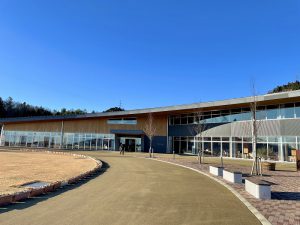
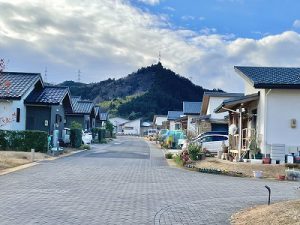
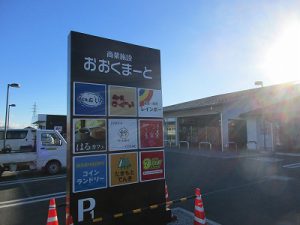
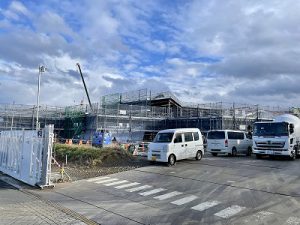
(2) Interim Storage Facility
The Interim Storage Facility spanning the towns of Okuma and Futaba was established to safely manage and store soil and radioactive waste removed as part of the decontamination process until the final disposal. Transportation of soil and contaminated waste to the massive 16-square kilometer facility began in 2015, and was largely completed by the end of March 2022, not including “Restricted area”. The total amount of approximately 13.38 million cubic meters of removed soil and waste (as of end of December 2022) was transported to the facility. The law stipulates that the removed soil and other wastes are to be temporarily stored in the Interim Storage Facility and then finally be disposed of outside of Fukushima Prefecture within 30 years after the start of the transportation (by 2045).
After an explanation from a Ministry of the Environment official, the tour will see the Soil Separation Facility, Soil Storage Facilities etc., covering this Interim Storage Facility which is vital for the reconstruction of Okuma to move forward.
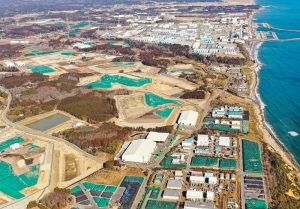
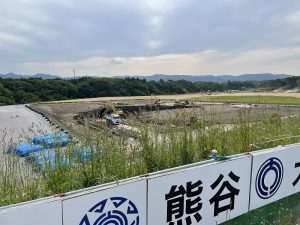
[Left photo: Provided by the Ministry of the Environment]
2. Decarbonization and Reconstruction: Namie’s Challenge
Namie which had a population of 21,434 people at the time of the disaster suffered great hardship due to the nuclear accident, with evacuation orders being issued for the entire town at one point. In March 2017, the evacuation orders were lifted in the center of the town, and people began to live their again, with a current population of 1,932 (as of the end of October 2022).
Namie has begun pioneering initiatives to move forward with both decarbonization and reconstruction at the same time. With the transition to a carbon neutral society being a global issue, this town which suffered due to nuclear energy is reimagining itself as a frontier for renewable energy and decarbonization.
(1) Becoming a Hydrogen Town
-A pioneering example of a hydrogen society, with hydrogen made in Namie
With efforts to achieve carbon neutrality by 2050, hydrogen is gaining attention as an environmentally friendly next-generation energy, and in March 2020, the Fukushima Hydrogen Energy Research Field (FH2R), one of the largest test facilities in the world producing hydrogen from renewable energy, began operations in Namie. The electricity generated from the around 68,000 solar panels installed in an area of approximately 180,000 square meters is used to produce hydrogen from water through electrolysis. The amount of hydrogen produced in one day is equivalent to what 150 average households would use in one month, making this one of the largest facilities of its kind in the world. The hydrogen made at the FH2R was used as fuel for the Olympic torch as well as for other purposes in the Tokyo 2020 Olympics and Paralympics.
Namie is placing its hopes on hydrogen made in Namie to become a pillar for its reconstruction. The town is promoting use of hydrogen energy and has announced a Hydrogen Town Concept, actively encouraging various hydrogen-related trial projects throughout the town. By utilizing locally produced hydrogen and being the first in the world to create a "hydrogen society," the project aims to attract businesses and younger generations to the town, and eliminate the negative image from the nuclear accident.
Since April 2022, a demonstration project has begun for building a hydrogen supply chain within the town. Hydrogen is transported from the FH2R to hydrogen demand centers, where it is used for electricity, hot water, and fuel for fuel-cell vehicles (FCV). The four hydrogen demand centers are the Ikoi no Mura Namie bathing facility, the Fureai Center Namie nursing center, the reconstruction project office, and Namie Town Hall (a simple hydrogen fueling station for public vehicles). Ikoi no Mura Namie uses electricity produced from hydrogen to heat its water, with its main bath even being named Suiso no Yu (Hydrogen Bath). Other planned projects in the town include a trial project for sending hydrogen through a pipeline built five meters above ground level on poles, and the development of the RE100 Industrial Park, covering all its energy needs with renewable energy including using hydrogen from FH2R.
In the town, the mobile hydrogen station "Namienergy" (May 2022), which stores hydrogen produced by FH2R in truck tanks and provides it to FCVs, and the stationary hydrogen station (December 2022) have also started operation, and "local production for local consumption of hydrogen" is progressing.
<Main Tour Stops>
・Fukushima Hydrogen Energy Research Field (FH2R)
・Ikoi no Mura Namie
・Mobile hydrogen station Namienergy
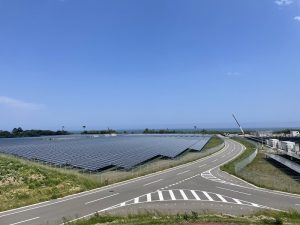

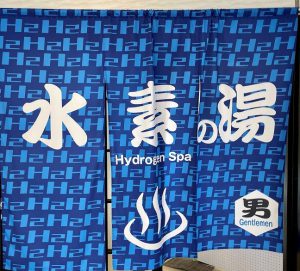
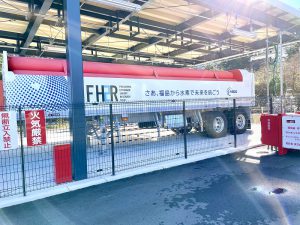
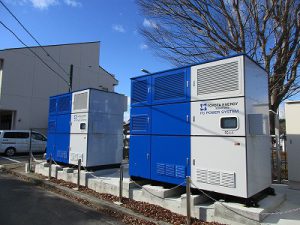
(2) Biomass Resin Fukushima, Namie Plant
-With plastic made from rice, aiming for both decarbonization and agricultural recovery after the disaster
At Kita Industrial Park in Namie, the Rice Resin production plant of Biomass Resin Fukushima (head office: Namie) began operations in November 2022. Rice Resin is biomass plastic made from inedible rice not even fit for animal feed that would otherwise be discarded, such as old rice and shreds generated in the process of making rice-based snacks. It is manufactured by mixing in rice with the petroleum-based resin plastic which is usually a raw material for plastics, and heating and processing. It can be processed into various shapes, as it is as durable as petroleum-based plastic, and is used in a variety of products such as garbage bags designated by the local government, spoons, and toys for children. The mix consists of up to 70% rice, reducing the usage of petroleum resources, and CO2 emissions can also be reduced.
At the Namie Plant, the materials used partially consist of rice grown to be used in Rice Resin, grown in fields in Namie and the neighboring village of Iitate that were abandoned for agricultural use after the nuclear accident by an affiliated company of Biomass Resin Fukushima together with the local producers cooperative. Production of Rice Resin is expected to increase in the future to up to 3,000 tons annually, which will require over 1,500 tons of rice annually. The company aims to increase the procurement of raw materials from local sources, which is expected to help ensure stable income for farmers affected by the disaster, as well as preserving agricultural land and lead to restarting the production of rice for human consumption in the future. They also hope this technology will spread to other rice-growing cultures in Asia.
The tour will hear from Biomass Resin Fukushima President IMAZU Takemitsu about the characteristics of Rice Resin, how fields left unused due to the disaster are being used to source materials, and creating local jobs, followed by seeing how Rice Resin is made.

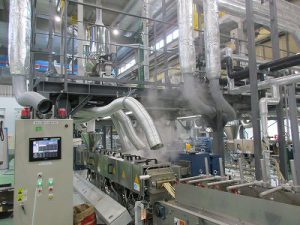

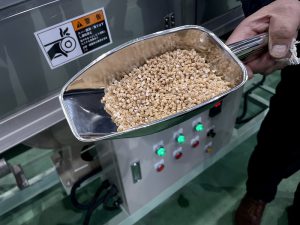
【Tour Itinerary】
- Dates:
Tuesday, February 14 to Wednesday, February 15, 2023
- Schedule
【Day 1】
07:12-08:30 Tokyo Station→Koriyama Station (Yamabiko 123)
10:45-12:15 Okuma, Ogawara area
12:15-13:00 Lunch
13:30-15:15 Interim Storage Facility
16:15-17:00 Interview with Okuma Mayor
17:15-18:00 Briefing by the Ministry of the Environment
18:00-18:40 Restaurant and Café Rainbow
19:15 Arrive at hotel
【Day 2】
08:45 Leave hotel
09:00-10:15 Biomass Resin Fukushima (Namie Plant)
10:30-12:00 Fukushima Hydrogen Energy Research Field (FH2R)
Mobile hydrogen station Namienergy
12:20-13:30 Ikoi-no-Mura Namie (Incl. Lunch)
14:00-15:15 To be arranged
15:30-16:10 Meeting with Okuma officials
19:31-20:48 Koriyama Station→Tokyo Station (Yamabiko 156)
- Qualification:
Bearer of the Ministry of Foreign Affairs of Japan Press Registration Card
- Cost:
13,000 yen per person, including transportation, accommodation (dinner and breakfast included), and lunch (for Day 2)
- Participants:
Limited to 10 applicants.
(Only one reporter or one photographer from each company, but two participants from each TV team will be acceptable.) * If the capacity is exceeded, the organizer may make adjustments.
- FPCJ Contact:
Watanabe (Ms.) and Sugawara (Mr.), Media Relations Division
(Tel: 03-3501-3405, email: ma@fpcjpn.or.jp)
- Measures to prevent spread of COVID-19:
Please follow the directions of the staff, such as taking temperature before the tour, wearing a mask, washing hands, and using disinfectant. In the following cases, you will not be able to join the tour:
(1) If you have a fever of 37.5°C or over when your temperature is taken before the tour starts
(2) If, in the 7 days before the day of the tour, you had a fever, cough, sore throat or other symptoms of a cold, difficulties in tasting or smelling, fatigue, shortness of breath, or other symptoms
(3) If, in the 7 days before the day of the tour, you came into close contact with someone who tested positive for COVID-19
(4) If a family member living with you or other close acquaintance is suspected of having COVID-19
(5) If, in the 7 days before the day of the tour, you travelled to a country under travel restrictions designated by the Government of Japan and have not completed the self-quarantine period, or came into close contact with such a person
- Others
(1) This tour is sponsored by Ministry of the Environment and run by the FPCJ.
(2) The schedule is subject to change without notice.
(3) This tour will require participants to bear a part of the cost, but is not a profit-making venture.
(4) The Ministry of the Environment and the FPCJ take no responsibility for any accidents, injuries, illness, or other problems which occur during the tour. Tour participants should apply for travel insurance coverage individually should they decide it is necessary.
(5) There may be some restrictions on photographing and filming at the tour sites. Please follow the instructions of the staff in charge.
(6) Please be aware that videos and photos of the tour, and articles about it, may be posted by the Ministry of the Environment and the FPCJ on their websites or social media.

